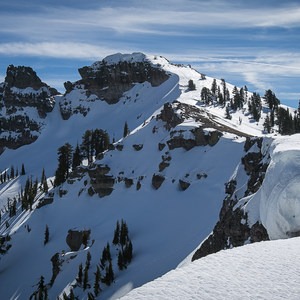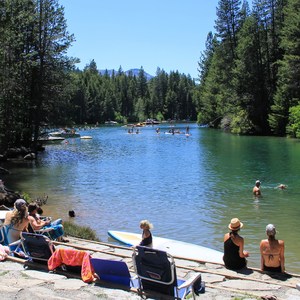Castle Peak (9,103 feet) is one of the few winter backcountry havens near the Donner Pass area that lies to the north of Interstate 80. With good ski terrain options for both storm and spring conditions, the Castle Peak area is a solid bet when conditions are questionable elsewhere. While the area's popularity means that you may not find yourself alone out here, a push to Castle Peak’s summit ridge opens up some breathing room and a diversity of descent routes that range from intermediate bowls and glades to advanced and expert couloirs, chutes and cliff-laden terrain.
Castle’s most popular and easily accessible descent is its broad south face. During freeze-thaw cycles, great corn snow forms, and laps on the 25- to 30-degree slopes below the buttress are open and enjoyable. When conditions allow, a 300-foot couloir can be ski'd from below Castle’s summit ridge and linked up with a longer run on the south face. Inspect the couloir ahead of time to ensure it goes through (important on low snow years) and to locate the entrance gully, which can be easily seen from the approach.
Access to Castle Peak is via a relatively flat, 1.75-mile unplowed road that is popular with snowshoers and cross-country skiers heading out to the Sierra Club’s Peter Grubb Ski Hut. Located in Round Valley adjacent and to the west of Castle Peak, the ski hut is ideally situated for spending a couple days exploring the terrain around Castle and Basin Peaks.
The unplowed road parallels I-80 eastward briefly before it bends north and splits into separate trails for snowmobiles and skiers and snowshoers. Follow the unplowed road up to Andesite Ridge where the trail splits at 7,880-foot Castle Pass; the left branch heads to the ski hut (this lower section of trail is part of the Pacific Crest Trail). Continue north up Andesite ridge onto the west shoulder of Castle Peak. The west shoulder steepens and can become firm, and a bootback or ski crampons may be useful to reach the summit ridge.
The view along the summit toward the Castle Peak-Basin Peak ridge and into the north bowl may inspire an alternate descent, but ensure good snow stability before venturing off into this terrain. During storm cycles Castle’s forested southern slopes and northwest facing glades above Round Valley are safer options.
Parking for Castle Peak is located off I-80 at the Castle Peak/Boreal Ridge exit. You can park in the Donner Summit Sno-Park (snow-park permit required) on the south side of I-80 and just east of Boreal Inn; walk north underneath the freeway to the trailhead. For day trips you can also park on the north side of the freeway adjacent to the start of the unplowed road. While the north side option does not require a sno-park permit, it quickly fills up and can get crowded. Overnighters must park at the Donner Summit Sno-Park.
Make sure to check Sierra Avalanche Center's daily winter avalanche bulletin to help inform safe backcountry decision making before venturing out: www.sierraavalanchecenter.org.































Comments
Sign In and share them.